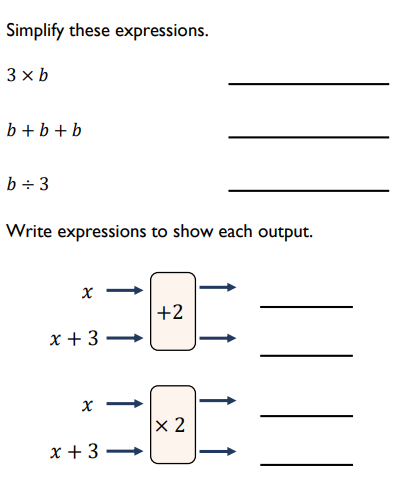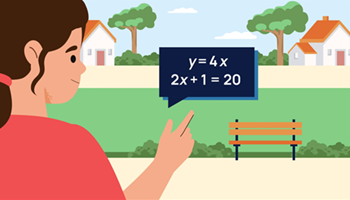Planning tool
Expected level of development
Australian Curriculum Mathematics V9: AC9M7A01
Numeracy Progression: Number patterns and algebraic thinking: P6
At this level, students recognise the notions of pronumerals and variables in formulas they have been exposed to. Present real-life scenarios and make explicit the relationship between variables using algebraic notation as a representation.
For instance, the floor in the school gym is l m long and w m wide; therefore, the area formula
is A = l × w. Substitute real-world measurements into the equation and have students find the remainder variable when only two are known. Change the variables by degrees so that students interpret and understand what the implications on the outcomes mean in the real-life scenario. This way students know why they are learning algebra and why they will be exposed to terms like variables and pronumerals.
Students will need to have multiple examples modelled and be given time to practise these skills. The use of concrete materials, such as algebra tiles, can be a good way for students to visualise the construction and manipulation of algebraic expressions.
Students use substitution to check answers and make connections as to why we use formulas in mathematics. For example, if your average heart rate is 65 beats per minute (BPM), and b represents beats and t represents time in minutes (BPM = b × t), what is the total number of beats counted over five minutes?
Teaching and learning summary:
- Introduce the concept of pronumerals and variables.
- Demonstrate how to form an expression or equation from a worded problem.
- Relate to other areas of mathematics, for instence, when finding the missing length in a perimeter.

Students will:
- write an expression or equation from a word problem using pronumerals
- substitute a value for a pronumeral into an expression (or formula)
- manipulate pronumerals in expressions mathematically.
Some students may:
- not comprehend that letters stand for a specific amount or unit of measurement – use the term ‘pronumeral’ to emphasise that it means ‘a number’,
- confuse the variable x with the multiplication symbol – explain that therefore we ‘drop’ the multiplication symbol.
- not realise that equations must be balanced.
The Learning from home activities are designed to be used flexibly by teachers, parents and carers, as well as the students themselves. They can be used in a number of ways including to consolidate and extend learning done at school or for home schooling.
Learning intention
- We are learning how to substitute values into formulas.
- We are learning what happens when we alter the value of variables.
Why are we learning about this?
Our lives are full of choices. Some do not matter all that much, but some matter a lot. We can use mathematics to predict what will happen if we change our initial decisions, to make sure we make the right choice for the outcome we desire. When planning to build a house, it is important to select the right dimensions for each room to make sure it is tall enough for us to walk in but also large enough to fit the necessary furniture and fittings.
What to do

Hint: Area of a rectangle = length x width.
- Grab any long, straight stick you can find in your garden, the bush or at the park. Your goal is to split it into four smaller sticks so that you can arrange them into a rectangle that encloses the largest possible area. That means you need to create the largest possible space inside the rectangle.
- How long should you make your pieces?
- Measure your stick in centimetres (for example, 262 cm – I got lucky and found a giant stick!).
- Halve this number, because you need two lengths and two widths to make an enclosed rectangle.
(In this example, that’s 131 cm.) - Create a spreadsheet to explore all the possible combinations of length and width measurements you could have in your rectangle. Follow the example below.
- Locate the maximum area value. You could use a formula for this such as =max(D2:D131).
- Try this a few times with different sticks. What patterns do can you find? Can you draw any general conclusions about the best way to split up the stick?

Extension task: Design your playroom
Your neighbours have finished building their new house and have 45 m of timber left over. They offer it to you so you can build a room in your garden. Your task is to choose what are the most appropriate dimensions for this room so you don't cut the timber to the wrong lengths! You will need to consider whether you prioritise length, width, height or a balance of all three. You are limited to a rectangular design.
There is a formula we will use for this task:
Total timber required = (4 × length) + (4 × width) + (4 × height)
This is because we are making a 3D room, which has 12 edges in total. Try to locate them on the diagram below.

Let’s try an example:
Width = 6m
Length = 7m
Height = 3m
Now we substitute these values into our formula.
Total timber required:
= (4 × 6m) + (4 × 7m) + (4 × 3m)
= 24m + 28m + 12m
= 64 m
Uh-oh. That’s not going to work. We only have 45 m of timber for this project.
- Can you find a set of dimensions that will work for this project?
- How much space (volume) will there be inside your room?
Remember: Volume = length × width × height for a rectangular prism. - Which set of dimensions will produce the largest possible volume?
Success criteria
- I can substitute values into formulas to solve problems algebraically.
- I can understand that when values of variables are altered a pattern emerges.
Please note: This site contains links to websites not controlled by the Australian Government or ESA. More information here.
Teaching strategies
A collection of evidence-based teaching strategies applicable to this topic. Note we have not included an exhaustive list and acknowledge that some strategies such as differentiation apply to all topics. The selected teaching strategies are suggested as particularly relevant, however you may decide to include other strategies as well.
-

Explicit teaching
Explicit teaching is about making the learning intentions and success criteria clear, with the teacher using examples and working though problems, setting relevant learning tasks and checking student understanding and providing feedback.
Go to resource -

Concrete, Representational, Abstract (CRA)
The CRA model is a three-phased approach where students move from concrete or virtual manipulatives, to making visual representations and on to using symbolic notation.
Go to resource -

Mathematics investigation
By giving students meaningful problems to solve they are engaged and can apply their learning, thereby deepening their understanding.
Go to resource -

Worked examples
A worked example is not just a pre-worked question that is given to the students. There are several types of worked examples and ways of using them.
Go to resource
Teaching resources
A range of resources to support you to build your student's understanding of these concepts, their skills and procedures. The resources incorporate a variety of teaching strategies.
-

Algebra basics: Video and teaching guide
Use this video as a springboard to introduce algebraic thinking, and to apply that thinking to a financial context, drawing on reasoning.
Go to resource -

Algebraic equations: Video and teaching guide
Use this video as a springboard to explore algebraic thinking, and to apply that thinking to a financial context, drawing on reasoning and mathematical modelling.
Go to resource -

Expressions, formulas and substitution
In this lesson, students will explore substituting values into familiar and unfamiliar formulas to determine an unknown.
Go to resource -
Formulating algebraic expressions
This lesson encompasses students’ introduction to formal algebraic concepts.
Go to resource -

Introduction to algebra
From the AMSI Supporting Australian Mathematics Project, this resource gives detailed explanations for teachers and students of the curriculum content, worked examples and assessment questions. This resource focuses on introducing algebra and the use of pronumerals.
Go to resource -

reSolve: Prisms and pyramids
This resource encourages students to make connections between their knowledge of 3D shapes and algebra. They look for the connection between the number of faces, edges and vertices and find a general rule (Euler's formula). The resource includes teacher notes and student sheets.
Go to resource -

The laws of arithmetic and their use in algebra
From the AMSI Supporting Australian Mathematics Project, this resource gives detailed explanations for teachers and students of the curriculum content, worked examples and assessment questions. This resource focuses on how to manipulate pronumerals in algebraic expressions.
Go to resource -

Writing equations to model relationships
This resource demonstrates step-by-step preparation for thinking algebraically. The student is guided through real-life worded problems that help students to identify the relationship between the variables. It comprises lesson goals, student-facing materials and practice tasks or assessments.
Go to resource
